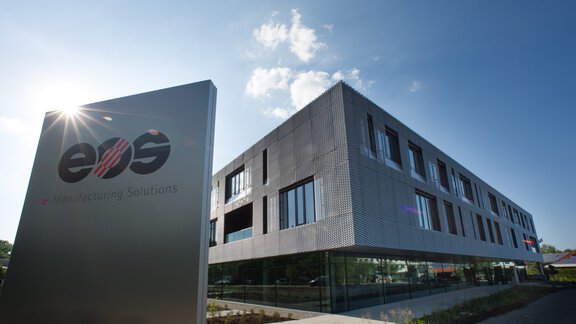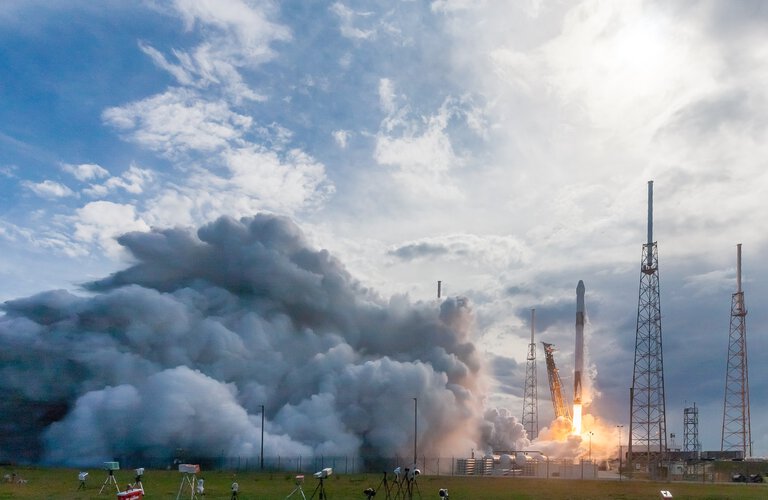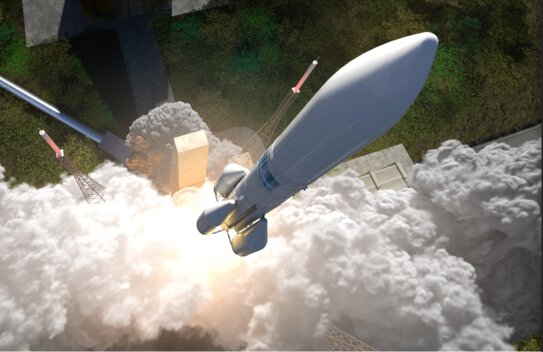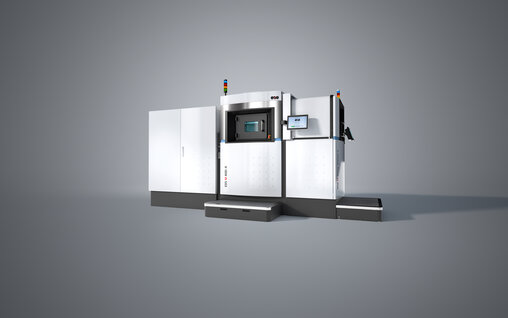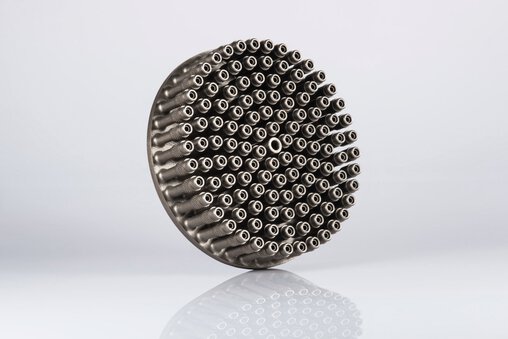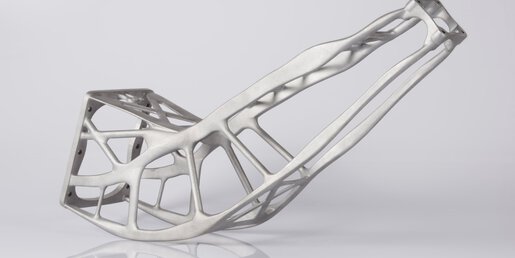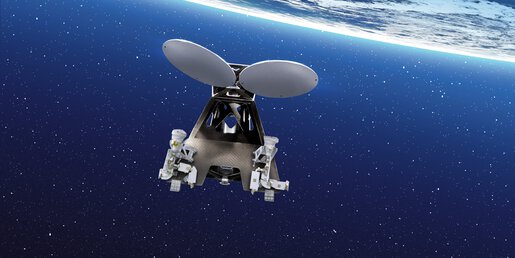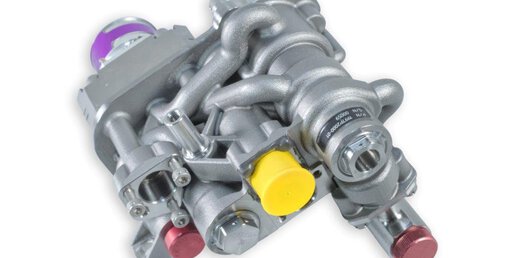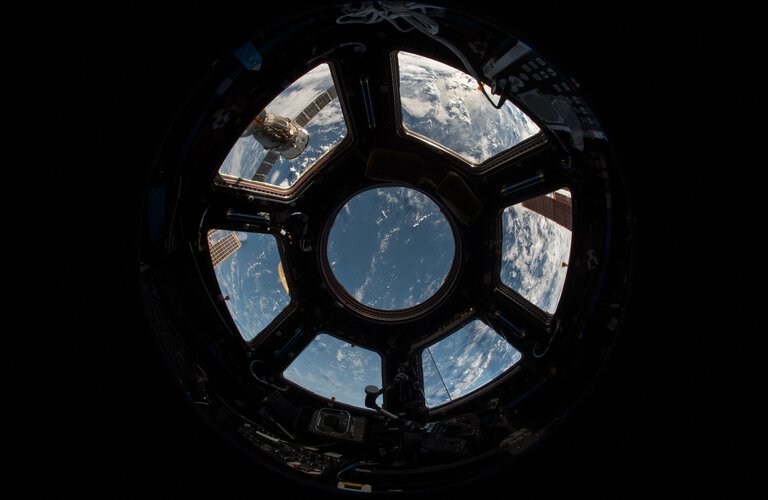All-in-one Design 122 injection nozzles and further parts as one integrated component
„Mission Critical“ perfectly describes the Class 1 components used in the aerospace industry. Missions costing hundreds of millions depend on these components. Accordingly, engineers are constantly seeking to develop components of the highest quality, functionality, and robustness while simplifying the manufacturing chain and reducing the number of individual elements. Thanks to EOS additive manufacturing technology, ArianeGroup has succeeded in taking this to a whole new level: Instead of 248 elements, the injector head of a rocket engine of a future upper stage propulsion module now counts just one component. The injector head has been simplified and reduced to what is literally an all-in-one (AiO) design.
On Ariane program, we are combining our innovative strength with the expertise of EOS. Together, we work on the additive manufacturing of an injector head for a rocket engine. The results are impressive: Significant reduction in production time and 50 % lower costs.
Challenge
Production of an injection head for rocket engines with as few components as possible and lower unit costs
The European Space Agency (ESA) wishes to assume a strong and independent position in space transportation using efficient launch vehicle technology. In order to achieve this, ArianeGroup, a joint venture by the European aerospace company Airbus Group and the French group Safran, was commissioned to construct the next generation. Ariane is a series of European launch vehicles designed to enable heavy payloads, such as communications satellites, to be put into orbit around the earth.
In a propulsion module, tremendous forces develop under extreme conditions. This demands maximum levels of reliability and precision in a small space. The injection head is one of the core elements of the propulsion module, feeding the fuel mixture into the combustion chamber.
Its traditional design consists of 248 components, produced and assembled in various manufacturing steps. The different processing steps, such as casting, brazing, welding, and drilling, can result in weak points that can constitute a risk under extreme loads. Moreover, it is a timeconsuming and complex process. In the field of injector elements, conventional production requires over 8,000 cross holes to be drilled in copper sleeves that are then precisely screwed to the 122 injector elements in order to mix the hydrogen that streams through them with oxygen.
A glance at these figures clearly shows that, one functionally integrated component combining all the elements must be the obvious but ambitious goal. This could also release significant economic potential and cut the number of processing steps as well as production time, especially for a Class 1 component.
Solution
An additively manufactured product that comprises a single element instead of 248 individual parts thanks to functional integration
The solution for these challenges is provided by additive manufacturing. “The production of the injector head in one piece is possible using EOS technology," says Dr.-Ing. Steffen Beyer, Head of Production Technology – Materials & Processes at ArianeGroup, explaining why industrial 3D printing was chosen. “Only additive manufacturing can combine integrated functionality, lightweight construction, a simpler design, and shorter lead times in a single component." The project team again chose a heat- and corrosion-resistant nickel-based alloy (IN718) as the material. This material provides excellent tensile, endurance, creep and fracture strength at high temperatures and and will also be used with the new production technology.
“After successfully developing the component, we turned our attention to cost efficiency," reports Dr. Fabian Riss, Production Technology – Materials & Processes. The key requirement from ArianeGroup was to reduce lead times and unit costs. Manufacturing was initially performed by an incremental process with the EOS M 290. After successful pilot tests, production was scaled up to the larger EOS M 400-4 system. 4-laser technology allowed the propulsion module component to be manufactured up to four times as fast. “Scaling up the construction process to the high-productivity EOS M 400-4 system was an important step for us in order to advance the industrialization and competitiveness of the Ariane project. The collaboration unfolded very efficiently thanks to the experience and industry expertise of EOS staff. The results speak for themselves and are proof of great team performance," adds Dr. Steffen Beyer.
Results
The results of the new injector head produced using additive manufacturing are extremely impressive: Instead of 248 parts, it consists of just one – with the same functionality, and cutting the required time down to a minimum.
The powder bed-based, industrial 3D printing technology from EOS meant that it was possible, for example, to print the 122 injection nozzles, the base and front plates, and the distribution dome with the corresponding feed pipes for the hydrogen and oxygen fuels as one integrated component. Compared with single-laser systems, the significantly higher productivity of the EOS M 400-4 multi-laser system was able to cut construction time by a factor of 3 and costs by 50 % in the example of the AiO injector head.
The project team was able to clock up a whole series of additional successes. The simplified design and the improved material properties compared with the quality of cast parts allowed the additive technology to reduce the wall thickness considerably – without losing any strength.
Cutting weight significantly also meants a further reduction in construction time and, of course, costs.
Last but not least, additive manufacturing processes allow innovation cycles to be sped up significantly. Structural improvements, design modifications, and the manufacture of test components in the development phase can be put directly into production based on CAD data without requiring engineers to spend time preparing tools, as is the case when casting parts. Industrial 3D printing thus achieves a quantum leap in terms of lead time. Whereas each iteration generally used to require around half a year, one iteration now only takes a few days. On top of this, the entire manufacturing chain now unfolds in-house on ArianeGroup's premises. In a nutshell: Mission accomplished!
